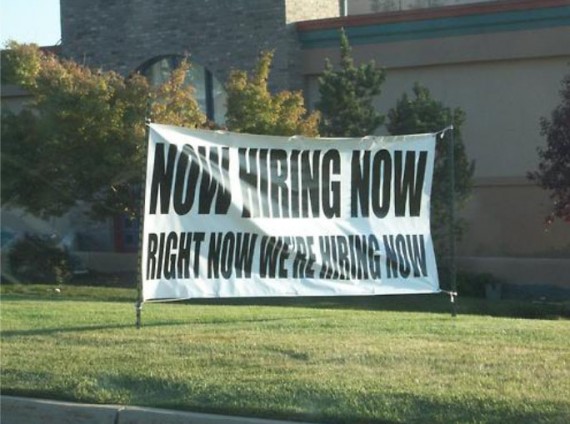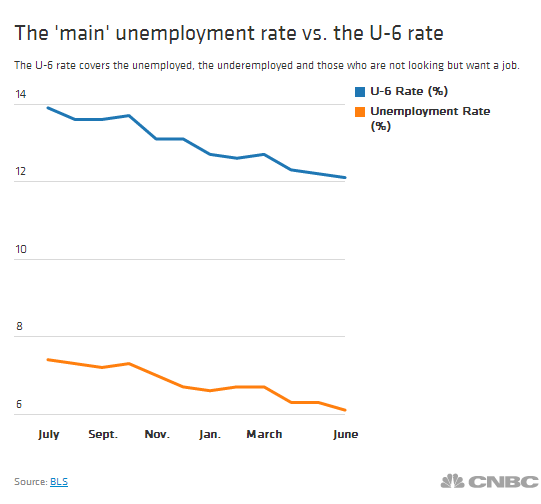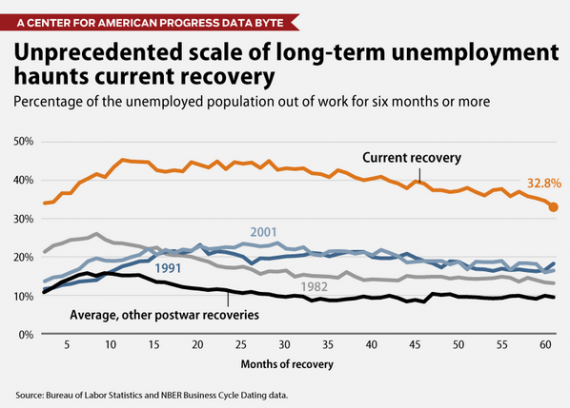June Jobs Report: Good News For The Start Of A Holiday Weekend
The June Jobs Report is basically good news.
Because tomorrow is the Fourth of July, the June Jobs Report was released a day early today, and it gives the nation some good news heading into the long holiday weekend:
In June, the unemployment rate declined by 0.2 percentage point to 6.1 percent. The number of unemployed persons decreased by 325,000 to 9.5 million. Over the year, the unemployment rate and the number of unemployed persons have declined by 1.4 percentage points and 2.3 million, respectively. (See table A-1.)
Among the major worker groups, the unemployment rates for adult women (5.3 percent) and blacks (10.7 percent) declined in June, and the rate increased for teenagers
(21.0 percent). The rates for adult men (5.7 percent), whites (5.3 percent), and Hispanics (7.8 percent) showed little change. The jobless rate for Asians was 5.1
percent (not seasonally adjusted), little changed from a year earlier. (See tables A-1, A-2, and A-3.)The number of long-term unemployed (those jobless for 27 weeks or more) declined by 293,000 in June to 3.1 million; these individuals accounted for 32.8 percent of the unemployed. Over the past 12 months, the number of long-term unemployed has decreased by 1.2 million. (See table A-12.)
In June, the civilian labor force participation rate was 62.8 percent for the third consecutive month. The employment-population ratio, at 59.0 percent, showed little change over the month but is up by 0.3 percentage point over the year. (See table A-1.)
(…)
Total nonfarm payroll employment rose by 288,000 in June. Over the past 3 months, job growth has averaged 272,000 per month. In June, employment growth was widespread, led by gains in professional and business services, retail trade, food services and drinking places, and health care. (See table B-1.)
Employment in professional and business services rose by 67,000 in June and had averaged 53,000 per month over the prior 12 months. In June, employment within the industry increased in management and technical consulting services (+8,000), architectural and engineering services (+7,000), and computer systems design and related services (+7,000). Employment continued to trend up in temporary help services.
Retail trade employment increased by 40,000 in June. Over the prior 12 months, employment in this industry had grown by an average of 26,000 per month. In June, job growth in the industry occurred in motor vehicle and parts dealers (+12,000), building material and garden supply stores (+8,000), and electronics and appliance stores (+7,000).
Employment in food services and drinking places rose by 33,000 in June and has increased by 314,000 over the past year.
Health care employment increased by 21,000 in June, about in line with the prior 12-month average gain of 18,000 per month. Within health care, employment continued to trend up in ambulatory health care services (+13,000) and in nursing and residential care facilities (+6,000).
Transportation and warehousing employment increased by 17,000 in June. Over the prior 12 months, this industry had added an average of 11,000 jobs per month. In June, couriers and messengers added 6,000 jobs.
Financial activities added 17,000 jobs in June, with a gain of 9,000 in insurance carriers and related activities. Employment in real estate and rental and leasing continued to trend up in June (+9,000). Financial activities had added an average of 5,000 jobs per month over the prior 12 months.
Manufacturing added 16,000 jobs in June, with all of the increase in durable goods manufacturing. Within durable goods, employment increased in motor vehicles and parts (+6,000) and in computer and peripheral equipment (+3,000).
Wholesale trade added 15,000 jobs over the month and has added 140,000 jobs over the year.
Employment changed little over the month in other major industries, including mining and logging, construction, information, and government.
There were also significant revisions to the jobs numbers for the previous two months, with April’s new jobs number revised upward from 282,000 to 304,000 and May revised upward from 217,000 to 224,000, for a total revision for the two months of 29,000 new jobs. For the first six months of the year, then, we’ve averaged roughly 230,800 new jobs created per months, and for the three months that comprise the second financial quarter of the year the average has been 272,000 new jobs per month. This last number is significant because it suggests that economic growth in the second quarter will be far healthier than the first quarter of the year, which saw the economy actually shrink by nearly 3% due in no small part to an unusually bad winter. Indeed, the three months between April and June have seen some of the best jobs growth that we’ve seen in years, and it’s only likely to get better as we get a final revision for May and revisions to the June numbers over the next two months. Additionally, the numbers are generally positive given the fact that the Labor Force Participation Rate, which remains at levels unseen since the Carter Presidency, was stable, which means pretty much all of the decline we see in the unemployment rate has been due to increases in employment. Average hourly wages also ticked up in June and average hours worked per week remained stable for the fourth month in a row, which is obviously good news for the people actually working.
CNBC take a cautious approach to the decline in the unemployment rate
The U.S. Labor Department said Thursday that the unemployment rate was 6.1 percent in June—but does that rate tell the real story?
A number of economists look past the “main” unemployment rate to a different figure the Bureau of Labor Statistics calls “U-6,” which it defines as “total unemployed, plus all marginally attached workers plus total employed part time for economic reasons, as a percent of all civilian labor force plus all marginally attached workers.”
In other words, the unemployed, the underemployed and the discouraged—a rate that still remains high.
The U-6 rate fell slightly in June to 12.1 percent. While it is down 210 basis points over the last year, the trend has been somewhat more volatile than in the main unemployment rate, which steadily declined.
This chart shows the differences in the levels of the U-3 rate and the U-6 rate:
And, as this chart from Vox shows, the long term unemployment rate has been far more stubbornly high in this recession/recovery than it has been in the past:
These caveats notwithstanding, there’s no denying that this is a good number, and more importantly that the trend that we’ve seen for 2014 in general and the last three months specifically bodes well for future job growth. Last month, we finally reached the point where the jobs lost in the Great Recession had been “recovered” in the bare sense that a numeric line was crossed. As I noted at the time, the important question isn’t just the number of jobs but the type of employment and how much those jobs pay. Another unknown is what happens when more of the people who have been sitting on the sidelines of the labor market start venturing back out into it looking for work. If these job creation numbers sustain themselves, they are likely to find a hospitable atmosphere, but it’s going to take many months of job creation numbers like this, and better, before all of those people are taken care of, assuming that they ever can be. For the most part, though, this is a good number, and another reason to celebrate this weekend.







Good news indeed…this should push the Dow over 17,000 and the S&P over 2000.
The Q1 GDP makes even less sense now.
If Republicans weren’t busy sabotaging the economy UE would be in the high 4% range now.
I@C. Clavin:
You are correct, I am an independent and have voted for many Republicans in my life but I don’t imagine how I could ever vote for a Republican again.
@C. Clavin:
I got a down-vote for that…I assume because some Republican doesn’t like facts.
Like the fact that this is the first President of the modern era who has not grown Government in the face of recession…because of Republicans.
This is the first modern President of the modern era who has reduced deficits in the face of a recession…because of Republicans.
There are 2 million net jobs missing because of radical Republican economic theories…add 2 million plus jobs back into the equation and everything changes.
I guess whoever down-voted my comment isn’t pleased with the damage Republicans are doing.
On a positive employment note, white trash unemployment dropped this week as production and sales of fireworks ramped up. It is due to drop further after this weekend when they move from unemployment to disability after blowing off their fingers.
Talk about mixed signals, eh? We got a wierdly bad 1st quarter GDP number, and then a good jobs report. Lots of noise in the signal.
I will be surprised if, looking back 6mos to a year from now, all this just adds up to “more muddling through.”
@C. Clavin:
But then you are saying that Paul Krugman was wrong and that the U.S. really did not need trillion of dollars in additional debt to fund pointless stimulus spending. If state and taxes were high enough to employ another 2-3 million people I doubt if the private sector economy would be hiring many people.
Also, what happen to all the claims that austerity is bad and the only way to lower unemployment is more governmentspending. Maybe the economist who argued that the U.S. should just take its economic medicine, ween itself from too much debt and have a slow steady economy were right. Also, how do progressives reconcile their belief that all good comes from the government with an improving economy when there has not been any significant legislation passed in the last four years?
@superdestroyer:
Can you re-write that…and try to make sense this time?
You want to know something amusing? In 2012, Romney boasted that by the end of his first term, the unemployment rate would have dropped to 6%!
http://politicalticker.blogs.cnn.com/2012/05/23/romney-promises-to-bring-unemployment-down-to-6/
At the time, this was a realistic but trivial promise, since that’s about where most economic forecasts suggested the unemployment rate would be by 2017 regardless of who was president. But now we aren’t even halfway through Obama’s second term and the rate has dropped to almost 6%. You can be sure that had Romney become president and faced the same numbers now (hardly a safe assumption considering he would have been pushing different economic policies), he and all his minions on Fox would be loudly touting it as proof of how Romney saved the country from the Obama recession.
(That actually was something I feared for a long time during the 2012 election cycle–I sensed that the economy was right on the brink of a true recovery, but that the mediocre conditions might be just enough to crush Obama in the election, enabling the new Republican president to falsely take credit once things improved after he took office.)
@Kylopod:
I would be willing to bet that it would be even lower…because the minute Romney was inaugurated the Republicans in Congress would have stopped obstructing and Romney would have been free to spend money and grow the Government…just like Republicans in the White House always do.
Executive version of the report…
We lost a ton of full time jobs and replaced them with part time jobs.
As we’ve been doing for many months.
@Kylopod: What you feared was their plan all along.
@Eric Florack:
You got the exact economy you wanted…Government is smaller and spending is being reduced.
What did you think was going to happen?
And why are you still complaining?
@C. Clavin:
Dow closed over 17,000 for the first time ever.
The S&P fell just short of 2000.
@ Florack
Well yea. Profit is the only thing that matter, right? Get rid of that HR hit, and you drive down labor costs, thus becoming more profitable.
Workers should not have leverage, right? All the power should rest with the job provider.
You are getting what you wanted. What’s the problem?